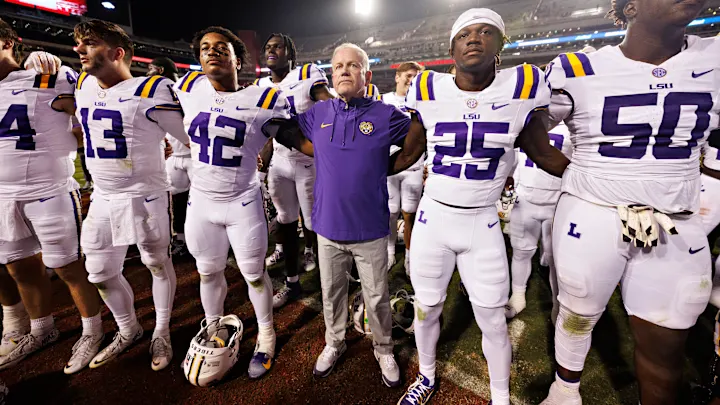Where does LSU stand among the top 5 defensive back transfer portal classes?

In recent years, the college football transfer portal has become an integral part of team building, particularly for programs looking to fill specific gaps in their roster. One of the most crucial areas of any football team, especially in the high-scoring era we find ourselves in, is the secondary. A strong defensive backfield can make all the difference in a game, providing coverage on passing plays, supporting against the run, and contributing to takeaways.
LSU, a program historically known for its exceptional defensive back talent, has leveraged the transfer portal to bolster its defensive back class in recent seasons. With Brian Kelly at the helm and the Tigers consistently attracting top-tier talent, LSU’s position in the top defensive back transfer portal classes is one that commands attention.
In this article, we’ll evaluate LSU’s defensive back transfer portal classes, comparing them with other elite programs in the country. We’ll explore the Tigers’ strategy, the players they’ve brought in, and how they stack up against other programs making waves in the transfer portal. By the end, we’ll answer the question: where does LSU stand among the top 5 defensive back transfer portal classes?
LSU’s Defensive Back Legacy and Need for Transfers
LSU’s history with defensive backs is nothing short of legendary. Over the years, the Tigers have produced some of the best cornerbacks and safeties in college football history. Names like Patrick Peterson, Tyrann Mathieu, and Tre’Davious White highlight a proud tradition of elite players in LSU’s secondary. However, even programs with such a storied history need to constantly adapt, and LSU is no different.
In recent years, LSU has faced some challenges in maintaining the same level of dominance in the secondary. While the team has recruited well, it has had to deal with injuries, player departures to the NFL, and the need for immediate contributors in the defensive backfield. This is where the transfer portal has played a significant role.
By leveraging the transfer portal, LSU has been able to fill gaps in its secondary with experienced players who can step in right away and make an impact. Unlike high school recruits, who require time to adjust to the college game, transfer portal players often bring with them the maturity and understanding of the game at a higher level, making them valuable additions to a roster.
LSU’s Transfer Portal Strategy
When evaluating LSU’s position in the transfer portal, it’s important to understand the Tigers’ strategy. Under head coach Brian Kelly, the program has maintained a commitment to building a balanced team, which includes strengthening key positions like the defensive backfield.
Kelly and his staff have been particularly adept at identifying players who can contribute immediately while also fitting the culture of LSU football. The Tigers have targeted defensive backs with a combination of experience, athleticism, and football IQ. They also place a significant emphasis on players who have proven themselves in Power Five conferences or have experience in competitive college football environments.
LSU’s approach has been selective but effective. Rather than casting a wide net and bringing in multiple players for a single position, the Tigers have focused on bringing in players who can immediately elevate their secondary. This strategy has paid off, as LSU has attracted top defensive back talent who can make an impact both on and off the field.
Evaluating LSU’s Defensive Back Transfer Portal Additions
To understand LSU’s standing among the top defensive back transfer portal classes, we must look at the specific players the Tigers have added in recent years. Below are some of the key transfers who have bolstered LSU’s secondary:
1. Jarrick Bernard-Converse (Cornerback, Oklahoma State)
Jarrick Bernard-Converse, a veteran cornerback from Oklahoma State, was one of the top transfer portal additions for LSU. With four years of starting experience in the Big 12, Bernard-Converse brought with him valuable experience and leadership to LSU’s secondary. Known for his physicality and ability to make plays on the ball, Bernard-Converse immediately became a key contributor for the Tigers.
During his time at Oklahoma State, Bernard-Converse showcased the ability to lock down top receivers and provide reliable coverage in both man and zone schemes. His experience in a pass-heavy conference like the Big 12 made him well-equipped to face the high-powered offenses in the SEC. His leadership and maturity were critical for LSU’s secondary, particularly with young players needing mentorship.
2. Greg Brooks Jr. (Safety, Arkansas)
Greg Brooks Jr., a safety from Arkansas, was another significant transfer for LSU’s defensive backfield. A versatile player who could line up both as a safety and a cornerback, Brooks brought a unique skill set to LSU. His ability to play in multiple roles, combined with his ball-hawking tendencies, made him a highly coveted player in the transfer portal.
Brooks was known for his playmaking ability at Arkansas, recording multiple interceptions and pass breakups over his career. His quickness and ability to read the quarterback allowed him to excel in coverage, while his tackling ability made him an asset in the run game as well. His leadership and experience in the SEC allowed him to immediately step into a starting role at LSU and make an impact.
3. Mekhi Garner (Cornerback, Louisiana)
Mekhi Garner, a transfer from the University of Louisiana, was another key addition for LSU’s secondary. Garner, who was a standout player in the Sun Belt Conference, earned recognition for his physical play and ability to cover top receivers. His size, athleticism, and ball skills made him an immediate contender for a starting role in LSU’s defense.
Garner’s ability to cover deep passes and his physicality in press coverage made him a strong asset for LSU. His transfer was seen as a significant coup for the Tigers, as he was able to bring a wealth of experience from a competitive conference. Garner’s development under LSU’s coaching staff has been closely watched, as he has the potential to become a key piece of the Tigers’ defense.
Comparing LSU to Other Top Programs in the Transfer Portal
While LSU’s defensive backfield has seen significant improvement through the transfer portal, it’s important to compare their efforts to other top programs who have also made a splash in the portal. Here are a few programs whose defensive back transfer portal classes have made waves:
1. Alabama
Alabama, under head coach Nick Saban, has been a constant force in recruiting, and the transfer portal has only added to their strength. In recent years, the Crimson Tide has added several key defensive backs from the portal, further bolstering their already elite secondary. Alabama’s ability to attract top-tier transfer talent, combined with their recruiting prowess, has made them the standard for defensive back development in college football.
2. Georgia
Georgia has also been an elite program when it comes to building its secondary, and they’ve used the transfer portal to enhance their already powerful defense. The Bulldogs have added several players with extensive experience in competitive programs, giving them an even deeper roster in the secondary. Georgia’s emphasis on size, speed, and versatility in the secondary has helped them maintain one of the best defensive units in college football.
3. Ohio State
Ohio State, known for its elite defense, has leveraged the transfer portal to improve its secondary. With the ability to attract top defensive back talent, Ohio State has added several players who have been able to contribute immediately. The Buckeyes’ strong recruiting combined with their portal success has made them a constant contender for the top defensive back classes in college football.
4. USC
USC, under head coach Lincoln Riley, has made a concerted effort to improve its defense, and the secondary has been a focal point. Through the transfer portal, USC has been able to add several key players who have helped shore up their defensive backfield. With a focus on athleticism and coverage skills, USC has made significant strides in improving its secondary, making them a program to watch in the coming years.
LSU’s Position in the Transfer Portal Rankings
When comparing LSU’s defensive back transfer portal class to these other elite programs, it’s clear that the Tigers are right in the mix. LSU’s ability to land top-tier players like Jarrick Bernard-Converse, Greg Brooks Jr., and Mekhi Garner places them in the upper echelon of transfer portal success. While programs like Alabama, Georgia, and Ohio State may have more established programs or deeper rosters, LSU’s recent transfers are making a significant impact on their defense, and the Tigers are a strong contender in the SEC.
LSU stands firmly among the top 5 programs for defensive back transfer portal classes, largely due to their strategic additions of proven talent. As the transfer portal continues to shape the college football landscape, LSU’s position as a key player in this area will only continue to grow, and their secondary will likely be a major strength moving forward.









